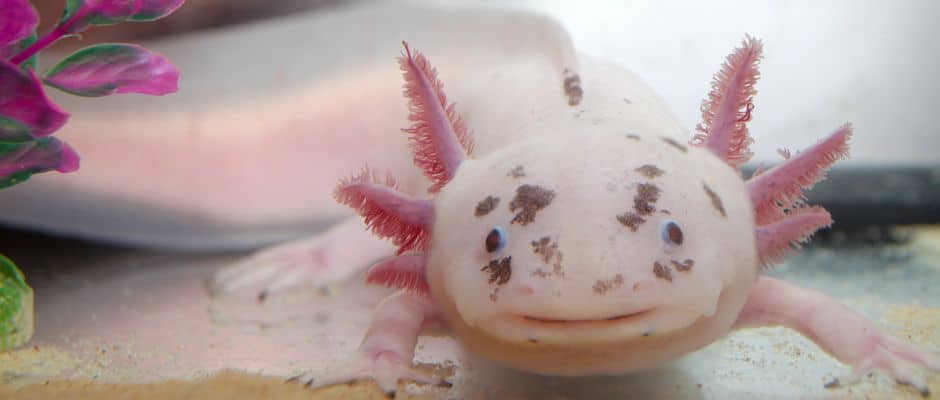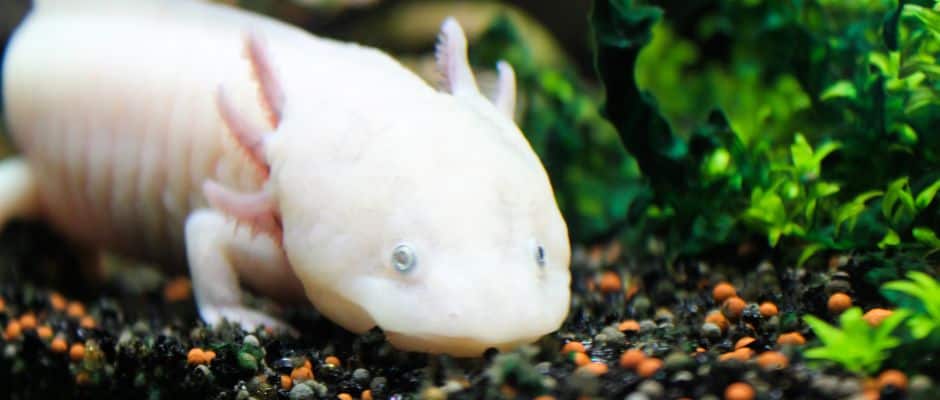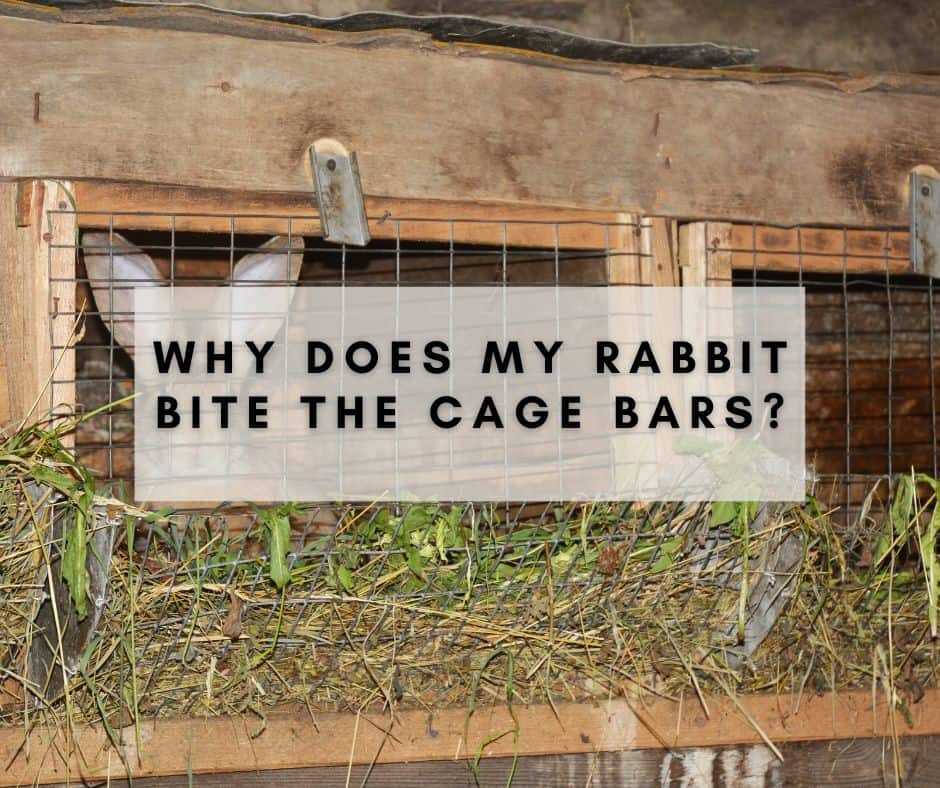Technically, axolotls already belong to the species of salamanders, having more aquatic traits than others in the same category.
But if you’re asking whether they can morph to develop more terrestrial characteristics then yes, it’s possible.
However, it’s a rare occurrence. The axolotls need the appropriate strain and circumstances to morph.
The hormone, called thyroxine (read more about that here: https://pubmed.ncbi.nlm.nih.gov/25740483/) , is secreted by a gland located in the neck of an adult salamander and triggers metamorphosis in juvenile amphibians.
It is believed that exposure to it could also cause metamorphosis in axolotls.
It’s important to note that this process can be both dangerous and unpredictable as the change is not always successful, so it should only be attempted by experienced professionals.
Contents
Axolotls as Salamanders
Since axolotls are already a specific type of salamander, they logically cannot turn into one.
What they can do is turn into another type of salamander. After all, they are closely related to North American tiger salamanders.
But unlike North American tiger salamanders, axolotls are mostly neotenic, meaning they do not develop past their juvenile stage and retain their aquatic features.
How Can Axolotls Morph?
Axolotls naturally do not morph. So, morphing can be seen as either spontaneous or painful, depending if they were forced into it or not.

Natural Metamorphosis
Based on the experiments by Professor Swingle from Yale, it can be assumed that the strains of axolotls are an integral part of the whole process.
Certain axolotls, such as the ones from New Mexico and America, tend to morph naturally.
Meanwhile, axolotls from Europe rarely morph and stay aquatic for the rest of their lives.
Although, there’s not much information regarding the natural occurrence of the metamorphosis.
Induced Metamorphosis
Metamorphosis in axolotls can start if the axolotl produces thyroxine. This hormone can trigger their development and cause them to become more terrestrial.
You can induce their morphing by exposing them to iodine which lets them produce thyroxine. However, this is very painful for them, and it’s discouraged to force the process.
Natural Habitat
Axolotls with little to no access to water can be forced to morph for survival. Habitat is also one of the reasons why they are neotenic.
Back then, they had abundant access to water, so they never found a reason to become terrestrial, hence the retainment of juvenile and mostly aquatic traits.
They’ll start developing more terrestrial traits if their environment doesn’t provide enough for aquatic creatures.
Based on the same experiments by Professor Swingle, it also found that axolotls tend to morph when they change localities. For example, from America to Europe.
How Can I Make Sure that My Axolotl Doesn’t Morph?
Axolotls are already critically endangered. It’s highly encouraged to keep their lineage running and refrain from triggering a metamorphosis.
- Make sure it’s an actual axolotl
The first thing you need to do is to make sure that you have an axolotl.
While it may seem unlikely to mistake a creature for another, it can happen!
Tiger salamanders, which are related to axolotls, can closely resemble axolotls at their juvenile stage, leading to confusion.
- Refrain from iodine exposure
As explained before, iodine triggers the production of thyroxine, which can force axolotls to morph.
- Provide the right environment
If you want your axolotl to stay aquatic, then it must be confident in surviving its environment as an aquatic creature.
Without sufficient water, your beloved pet may be forced to morph for survival.
You also need to check the water conditions and see if the temperature level is appropriate for an axolotl.
Lastly, test if the ammonia and nitrate levels are too high with a test kit.
How to Differentiate a Salamander from An Axolotl?
Salamanders have different feet than axolotls, fatter and rounder than the pointy and webbed ones that axolotls have.
They also swim differently. Axolotls swim like fishes, wiggling around in the water.
On the other hand, salamanders often swim like turtles, using their hands to navigate.
Unfortunately, they can be difficult to differentiate at their juvenile stages as they look similar when young.
How to spot a morphing axolotl
These signs should help pet owners navigate the stages of their axolotl’s life and whether they’ll stay in their aquatic form.
- Behavioral Changes
Your axolotl may start to come out of the water more frequently than the usual aquatic creature.
It may mean that your axolotl is preparing to morph or they have poor water quality.
- Appearance
Changes in appearance can mean that your axolotl is preparing to be a terrestrial creature.
- Bulging eyes
Axolotls usually have poor eyesight because they’re aquatic creatures. That’s why they have small eyes that don’t protrude much.
So, if they’re morphing, they’ll need better eyesight since they’ll be mostly out of water. Hence, the bulging eyes.
- Formation of eyelids
Terrestrial creatures need more protection from dry eyes, unlike aquatic creatures that already live in water.
If your axolotl is morphing, you may notice that they’re growing eyelids, much thicker for an aquatic creature.
- Thicker legs
Since being in the water makes them lighter, axolotls usually have thinner legs.
But if it’s undergoing metamorphosis, you may notice your axolotl develop a lot thicker than most of their kind.
- Rounder and fatter feet
Axolotls who are preparing to become terrestrial no longer need webbed feet. Their toes will be a lot thicker too!
If you’re still unsure, you can google a picture of a tiger salamander’s feet along with the average axolotl ones and compare your pet’s feet between the two.
- Skin changes
Morphed/Morphing axolotls tend to develop darker tones, often becoming black as ink.
If not, they may also develop intense patterns that are unusual for axolotls.
- Receding fin
Their fin will be absorbed into their body, no longer needing a propeller as a terrestrial creature.
If your axolotl doesn’t have any health conditions to explain the fin receding, it may be a sign of morphing.
- Loss of gills
The feathery parts around the head, along with the stalks themselves, will gradually be absorbed into their body.
It is a telltale sign that your axolotl is morphing. After all, why would they need gills if they’re going to live on the land from now on?

Can I Stop My Axolotl from Morphing?
It depends on the cause of their metamorphosis. If it’s due to their living conditions, it may be possible to stop the process.
However, if they’re morphing because of increased production of thyroxine then there’s not much that you can do.
The best course of action will always be early prevention and the application of precautions.
After all, even adults can undergo metamorphosis if forced. It’s more dangerous during this time too.
What to Do Right After Metamorphosis
Morphed axolotls can be tricky to manage, mostly because you’ve prepared for an aquatic pet, not a terrestrial one!
So, here’s a quick guide on what to do if your axolotl has completely morphed.
Step 1: Removal from the tank
Newly morphed axolotls need air to breathe while having a sense of familiarity.
An aquarium would no longer be appropriate since it needs shallow water. If you do not have the right equipment, you can temporarily put it inside a tub.
Step 2: Providing a landmass
Immediately put a landmass inside the tub. It needs a stable platform with an easy climb. A stone should suffice as long as it doesn’t have any sharp edges that can potentially harm your axolotl.
Step 3: Provide a shelter
To reduce the stress that your axolotl is receiving, especially from visual stimulants, provide a cover they can hide under.
Step 4: Cover
Now that they’ve been blessed with terrestrial feet, they’ll be able to escape quicker and easier.
Do not let their newly found skill be used. After all, your axolotl isn’t that familiar with the dangers of the surface yet.
Step 5: Space
Imagine going through a process that changes the entirety of your being. It’s literally life-changing and can be very stressful.
So, if needed, give your axolotl some space and refrain from touching them after they’ve completed the metamorphosis.
They may need some time for themselves to mentally process the change.
Post-metamorphosis
Now that you’ve both calmed down from the stress of metamorphosis, or the stress of taking care of a creature undergoing it, you now have to deal with changes in living conditions.
From the aquarium to a vivarium
Remember, your axolotl isn’t an aquatic creature anymore. Try to provide the applicable living conditions for a terrestrial.
You need to revamp their aquarium and turn it into a vivarium, adding a lid to prevent escape.
Soil
As a terrestrial creature, your morphed axolotl will need some form of a substrate to dig around and keep happy.
Fortunately, local pet stores usually have some for sale. Avoid the ones that tend to be acidic.
Diet
Their diet is relatively the same, but you can also introduce live food that salamanders typically eat.
If you’re unsure, check with your veterinarian about the proper diet now that your axolotl’s a terrestrial.
Conclusion
Axolotls, while a rare occasion, can morph due to a variety of reasons.
And while there are different reasons, the outcome is the same. A more terrestrial creature and a lower lifespan.
If you don’t want to stress out your pet and possibly kill them, refrain from inducing a metamorphosis.
But if it does occur, ensure that you provide the best living conditions to give your axolotl the best chance of survival. Good luck!
Disclaimer: This blog post is just for informational purposes only and should not be used as a substitute for professional medical advice. If you have any concerns or questions about your pet’s health, please contact a licensed veterinarian. Thank you!





